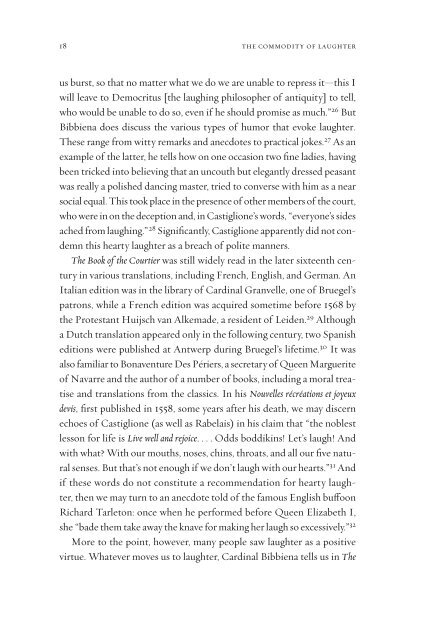Pieter Bruegel and the Art of Laughter - AAAARG.ORG
Pieter Bruegel and the Art of Laughter - AAAARG.ORG
Pieter Bruegel and the Art of Laughter - AAAARG.ORG
You also want an ePaper? Increase the reach of your titles
YUMPU automatically turns print PDFs into web optimized ePapers that Google loves.
18 <strong>the</strong> commodity <strong>of</strong> laughter<br />
us burst, so that no matter what we do we are unable to repress it—this I<br />
will leave to Democritus [<strong>the</strong> laughing philosopher <strong>of</strong> antiquity] to tell,<br />
who would be unable to do so, even if he should promise as much.” 26 But<br />
Bibbiena does discuss <strong>the</strong> various types <strong>of</strong> humor that evoke laughter.<br />
These range from witty remarks <strong>and</strong> anecdotes to practical jokes. 27 As an<br />
example <strong>of</strong> <strong>the</strong> latter, he tells how on one occasion two fine ladies, having<br />
been tricked into believing that an uncouth but elegantly dressed peasant<br />
was really a polished dancing master, tried to converse with him as a near<br />
social equal. This took place in <strong>the</strong> presence <strong>of</strong> o<strong>the</strong>r members <strong>of</strong> <strong>the</strong> court,<br />
who were in on <strong>the</strong> deception <strong>and</strong>, in Castiglione’s words, “everyone’s sides<br />
ached from laughing.” 28 Significantly, Castiglione apparently did not condemn<br />
this hearty laughter as a breach <strong>of</strong> polite manners.<br />
The Book <strong>of</strong> <strong>the</strong> Courtier was still widely read in <strong>the</strong> later sixteenth century<br />
in various translations, including French, English, <strong>and</strong> German. An<br />
Italian edition was in <strong>the</strong> library <strong>of</strong> Cardinal Granvelle, one <strong>of</strong> <strong>Bruegel</strong>’s<br />
patrons, while a French edition was acquired sometime before 1568 by<br />
<strong>the</strong> Protestant Huijsch van Alkemade, a resident <strong>of</strong> Leiden. 29 Although<br />
a Dutch translation appeared only in <strong>the</strong> following century, two Spanish<br />
editions were published at Antwerp during <strong>Bruegel</strong>’s lifetime. 30 It was<br />
also familiar to Bonaventure Des Périers, a secretary <strong>of</strong> Queen Marguerite<br />
<strong>of</strong> Navarre <strong>and</strong> <strong>the</strong> author <strong>of</strong> a number <strong>of</strong> books, including a moral treatise<br />
<strong>and</strong> translations from <strong>the</strong> classics. In his Nouvelles récréations et joyeux<br />
devis, first published in 1558, some years after his death, we may discern<br />
echoes <strong>of</strong> Castiglione (as well as Rabelais) in his claim that “<strong>the</strong> noblest<br />
lesson for life is Live well <strong>and</strong> rejoice....Odds boddikins! Let’s laugh! And<br />
with what? With our mouths, noses, chins, throats, <strong>and</strong> all our five natural<br />
senses. But that’s not enough if we don’t laugh with our hearts.” 31 And<br />
if <strong>the</strong>se words do not constitute a recommendation for hearty laughter,<br />
<strong>the</strong>n we may turn to an anecdote told <strong>of</strong> <strong>the</strong> famous English buªoon<br />
Richard Tarleton: once when he performed before Queen Elizabeth I,<br />
she “bade <strong>the</strong>m take away <strong>the</strong> knave for making her laugh so excessively.” 32<br />
More to <strong>the</strong> point, however, many people saw laughter as a positive<br />
virtue. Whatever moves us to laughter, Cardinal Bibbiena tells us in The












